Bulletin – March 2017 Australian Economy Housing Market Turnover
- Download 1.20MB
Abstract
The rate of housing market turnover, an important indicator of housing market conditions, has trended lower since the early 2000s. This is partly because households are moving less often and fewer own their own homes. More recently, the increase in apartment building is likely to have resulted in measured turnover being understated. A lower housing turnover rate could reduce housing-related economic activity and might lead to lower household leverage than otherwise.
Introduction
Housing market turnover is defined as transactions in the housing market involving the transfer of ownership. After rising for a number of years, the rate of housing turnover (that is, the number of transactions relative to the stock of housing) has trended lower since the early 2000s (Graph 1). The most recent decline in the turnover rate has been unusual, particularly given the strength in other indicators of national housing market activity, such as housing prices.
The rate of housing turnover helps inform assessments of conditions in the housing market and can also influence broader economic conditions. To the extent that housing transactions are financed by debt, the value of housing turnover will be closely related to the value of housing loan approvals and subsequently housing credit growth. Changes in the housing turnover rate can directly affect income and employment in related industries, such as real estate services and other professional services, and have spillover effects on household spending through various indirect channels. Tax paid on the transfer of property ownership is also a key source of state government tax revenue.
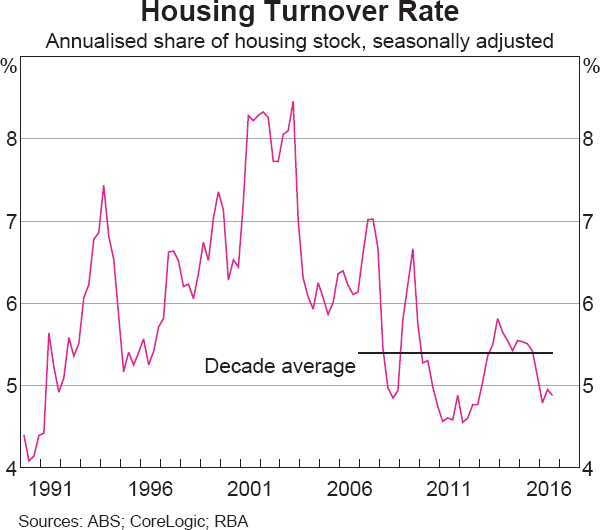
In this article, we provide an overview of some factors that might influence measured housing turnover in Australia. Household-level survey data, in addition to aggregate economic indicators, are used to examine possible reasons for the decline in the housing turnover rate over the past decade or so. This is followed by a discussion of measurement challenges arising from the recent increase in off-the-plan sales of new apartments. We also examine some broader implications of housing market turnover for economic activity and household balance sheets.
How Is Housing Turnover Measured?
In Australia, the most complete set of housing sales data is collected by the state and territory Valuers-General or Land Titles Offices. These agencies receive detailed sales information at the time a housing transaction is settled, which usually includes the date at which the purchase was agreed and contracts were signed. Other parties, such as private research companies, then aggregate these unit-record data to construct regional measures of turnover based on the contract date of the sale. As a result, the length of time between the contract date and settlement date of housing transactions can influence the completeness of recent data. This lag is especially long for off-the-plan apartment sales, which typically occur before construction has begun and are not settled until a few years later when construction is complete.
To overcome some of these limitations, private research companies often supplement official state government data with industry sources. For example, CoreLogic collects information from real estate agents, listings websites and other sources.[1] To address the issue of lengthy publication lags further, CoreLogic estimates housing turnover by adjusting for the historical pattern of revisions to turnover data and, more recently, has applied modelling which incorporates residential listings.
The Australian Bureau of Statistics (ABS) also reports housing turnover (‘transfers’) using CoreLogic's unit-record database. The ABS does not adjust for missing observations and as a consequence its measure of housing turnover is typically lower than CoreLogic's, although upward revisions to the ABS data tend to bring the series closer together over time.
Drivers of Housing Turnover
Households decide to move for many reasons, stemming from both personal circumstances and macroeconomic conditions. Data from the Household, Income and Labour Dynamics in Australia (HILDA) Survey show that the main reasons why owner-occupiers move home have not changed much over the past decade. In 2015, the most common single reason cited for moving by home owners was to have a place of their own (about 30 per cent), followed by having a larger or better place (about 22 per cent). A number of reasons relating to family and friends, such as moving closer, were also cited by a large proportion of home owners.
Not surprisingly, the reasons for moving differ by age. Older owner-occupiers (aged 55 years and above) more commonly cite downsizing and location, whereas those aged 35 to 54 years are more often buying larger or better properties. Younger home owners (aged 18 to 34 years) appear to be the least concerned with the location of the home and more frequently prioritise having their own place and family and friends in their moving decision. Moving for work is not a common reason for buying a home, regardless of age, which might reflect a view by some households that work is a temporary reason for moving and therefore not sufficient to commit to home ownership.
While the reasons for moving have not changed much over time, the HILDA Survey shows that households are moving less often than they were in the early 2000s (Graph 2).[2] The largest declines in moving frequencies that involve the transfer of ownership have been for renters transitioning to owner-occupiers and then owner-occupiers moving between dwellings.[3] Even when controlling for various demographic and income characteristics which may affect the decision to move, the probability of owner-occupiers having moved in the previous year appears to have declined since the early 2000s, particularly if owner-occupiers were renters in the previous year.
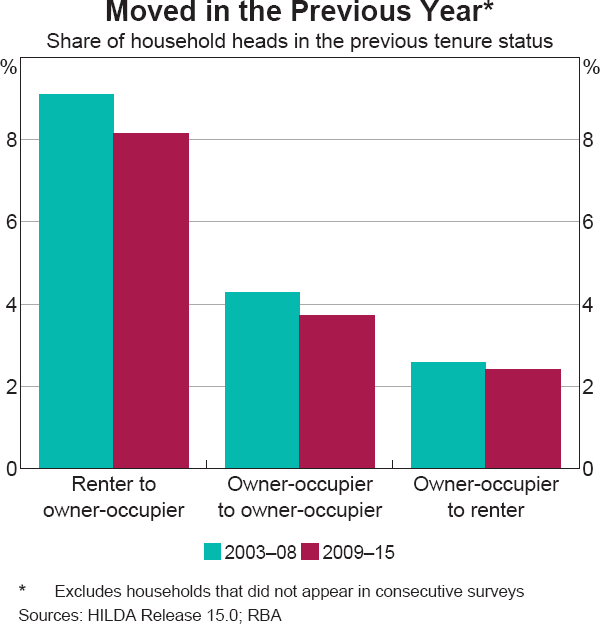
The factors that affect the propensity of households to move, and therefore housing turnover, are closely related to the drivers of home ownership, which are explored in detail in RBA (2015). For example, the consequences of disinflation and financial deregulation included a significant increase in many households' borrowing capacity during the late 1990s and early 2000s. This likely contributed to relatively high rates of housing turnover in that period. On the other hand, financial and other costs can discourage households from moving frequently, particularly when the purchase of a home is involved.[4] Demographics are another important factor affecting home ownership and housing turnover. Regression analysis suggests that being in a relationship increases the probability of transitioning from being a renter to an owner-occupier and the probability of transitioning between dwellings as an owner-occupier. The magnitude of the effect is much larger for the former transition, suggesting that people are inclined to wait until partnering before purchasing a home. Higher incomes and higher levels of education are also particularly important factors that increase the probability of transitioning from renter to owner-occupier.
Another demographic factor potentially affecting housing turnover is the age composition of home owners. Data from the ABS Survey of Income and Housing show a small increase in the aggregate share of renter households, driven largely by households with a household head aged under 55 years (Graph 3). All else being equal, a larger proportion of renter households would be expected to reduce housing turnover, to the extent that turnover measures home sales as opposed to household moves.[5] Given that renters tend to be disproportionately younger households, this suggests that older owner-occupier households represent a larger share of housing turnover than in the past. If these older households have a tendency to move less frequently (for example, because of more stable employment, established social networks and a preference to age in their own homes), this could imply a potentially lower equilibrium rate of housing turnover (Olsberg and Winters 2005).[6]
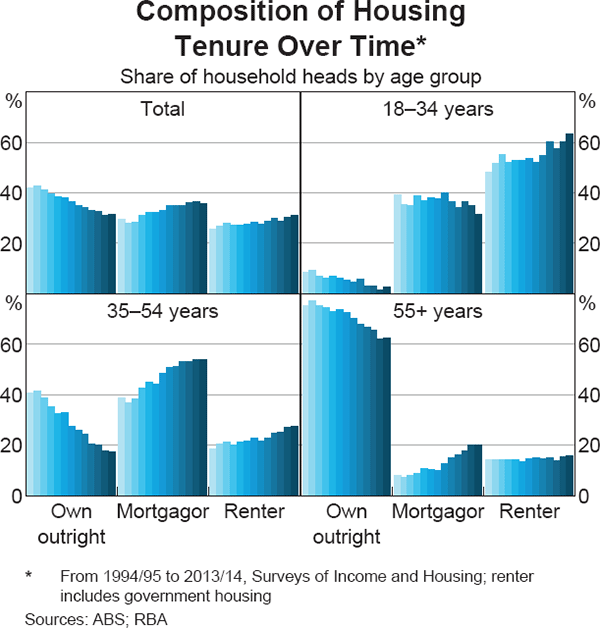
Another driver of housing turnover is migration, to the extent that households moving between states or countries are purchasing or selling homes. The decline in the turnover rate since the early 2000s appears to have been associated with a significant decline in the rate of gross interstate migration (Graph 4). As previously discussed, the decision to move reflects an interaction between various benefits and costs. For example, moving interstate may bring households closer to family and friends or better employment opportunities, but can involve high costs. Structural factors such as improvements in technology and the changing nature of work are likely to have reduced the benefits of interstate migration while increasing insecurity around employment and income, which would be expected to weigh on the housing turnover rate (Bachmann and Cooper 2014; Kaplan and Schulhofer-Wohl 2015; RBA 2015). In the United States, lower housing turnover rates have also been associated with a long-run decline in interstate migration, which in turn has been linked to declining labour mobility (Molloy, Smith and Wozniak 2014).
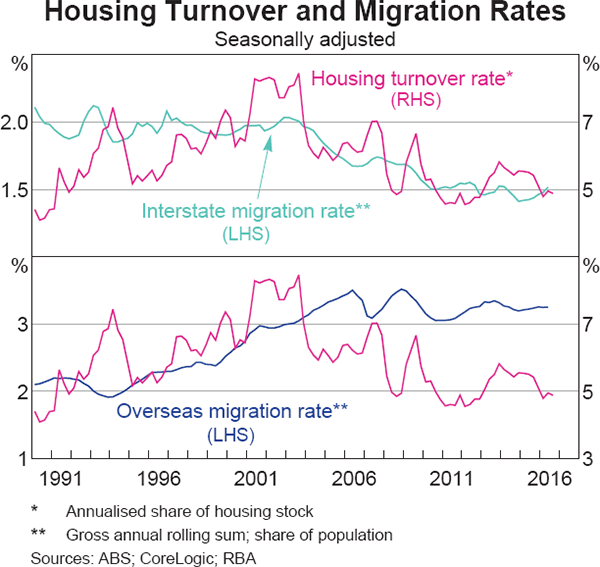
By contrast, the relationship between rates of housing turnover and gross overseas migration (the sum of overseas immigration and emigration) appears to have been less strong. The increasing housing turnover rate during the 1990s and early 2000s was associated with a rise in the rate of gross overseas migration, although the decline in the turnover rate since then has occurred alongside a relatively high gross overseas migration rate. While higher rates of gross overseas migration would be expected to have a positive effect on the housing turnover rate, this relationship could operate with a lag given that a large proportion of new immigrants tend to rent their first home in Australia before later transitioning to home ownership (Khoo et al 2012). Students also comprise a large share of new migrants to Australia and are likely to be less able and inclined to purchase housing than the average household (RBA 2015).[7]
Housing Turnover and the Recent Increase in Apartment Building
The decline in the national housing turnover rate in recent years has occurred despite strength in a number of housing market indicators such as national housing price growth, which has historically been positively correlated with the turnover rate. While the previous section outlined some potential reasons for the longer-run decline in the housing turnover rate, part of the recent weakness could be due to measurement issues arising from the increased share of apartments in new housing construction.
Private residential building approvals for higher-density housing have increased sharply since 2009 and now account for around half of all approvals (Graph 5).[8] Meanwhile the apartment turnover rate, which has historically moved in line with building approvals, has declined. Evidence from business liaison suggests that the majority of new apartments are purchased off-the-plan, well before construction has commenced, and that off-the-plan sales have settlement lags of around two or three years (Shoory 2016). However, data providers have limited information about these sales until settlement, implying that contract-dated measures of housing turnover are likely to be understating actual turnover in the most recent years. Elevated levels of new apartment construction would be expected to increase the degree of this understatement.
One way to approximate the extent of the understatement of apartment turnover is to estimate the share of turnover that relates to new apartments versus existing apartments. This information can then be used to adjust the most recent data. The ABS and private research companies publish data on house and apartment turnover separately but are not able to disaggregate turnover by new and existing housing. We use the number of higher-density building approvals as a proxy for new apartment turnover and estimate the turnover of existing apartments as a residual. In doing so, we assume that the approval and contract dates are equivalent and that all approved construction is completed. This seems to be a reasonable proxy for new apartment turnover given that a large proportion of new apartments are sold before being built and housing turnover is measured at the contract date of the sale.
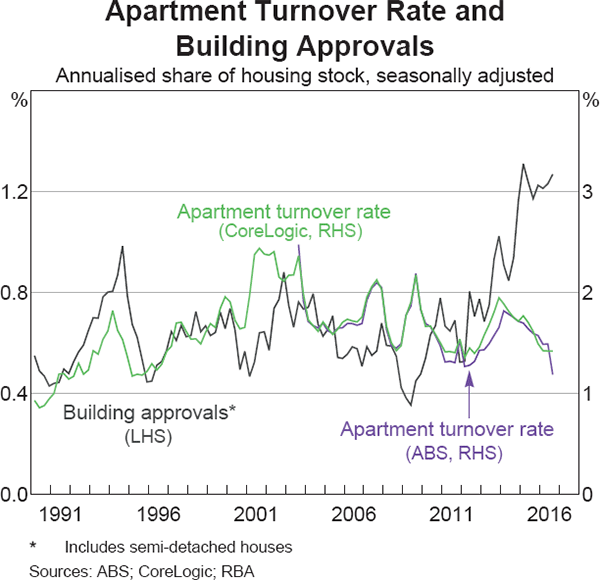
The recent sharp increase in higher-density building approvals seems to imply that turnover of existing apartments has fallen significantly since 2014 to around zero (when estimated as the ABS measure of total apartment turnover minus higher-density building approvals). This seems unlikely, suggesting that total apartment turnover is understated. We can estimate the effect of the understatement by adjusting existing apartments' share of turnover to more reasonable levels. For example, keeping the share constant from the June quarter 2014 (at around 18 per cent) and scaling up the volume of total turnover implies that the actual apartment turnover rate may be around ½–¾ percentage point higher than reported over this period (Graph 6).[9] Under these assumptions, apartment turnover appears to have increased sharply through the second half of 2014 and early 2015, before declining to around 2 per cent of the housing stock. The aggregate housing turnover rate would have also increased through late 2014 and early 2015 under these assumptions, before declining to be below its decade average rate.[10]
Although CoreLogic publishes modelled estimates of housing turnover, the pattern of revisions to these data over recent years suggests that the estimates have not been fully adjusted for the increased share of off-the-plan sales. For example, upward revisions to apartment turnover have been substantial for several years after the data were first released. By contrast, revisions to house turnover tend to be limited after a few months. Scaling up reported apartment sales from mid 2014 onwards by CoreLogic's average two-year revision rate produces similar estimates to the above exercise.
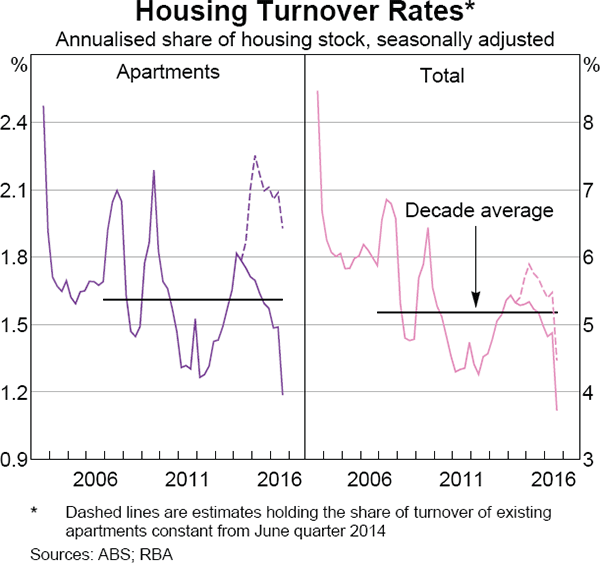
Implications for Economic Activity
Developments in the rate of housing market turnover can affect broader economic activity through several channels. A number of occupations are involved in housing transactions; these include real estate agents, lawyers and finance professionals. A decline in the rate of housing turnover would be expected to generate less employment and income growth for these professions at the margin.
Housing turnover also affects property tax revenue, which accounted for about 40 per cent of total state tax revenue in 2014/15.[11] More than half of property tax revenue is typically derived from tax paid on the transfer of property ownership (stamp duty). All else being equal, a decline in the number of housing transactions would be expected to reduce stamp duty revenue. However, given that stamp duty is calculated as a proportion of the sale price of the property, strong growth in national housing prices can more than offset a decline in turnover, as occurred in 2014/15 (Graph 7). The interaction between housing turnover and price growth, as well as state differences in the rate of property taxation, concessions and surcharges, can therefore affect government spending and budget outcomes.
Housing turnover can have a number of indirect effects on household spending. For example, housing turnover is positively correlated with household retail spending, particularly on durable goods such as furniture, home appliances and electrical or electronic devices (Graph 8). Renovation activity is another channel through which housing turnover can indirectly affect household spending, as new owners might choose to modify homes to suit their needs or existing owners might renovate to add value to their home before listing. Renovation activity would also be expected to have flow-on effects for activity in the construction industry.
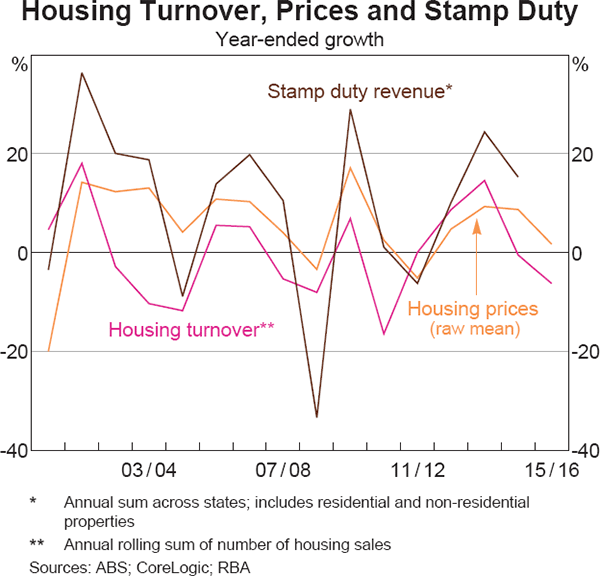
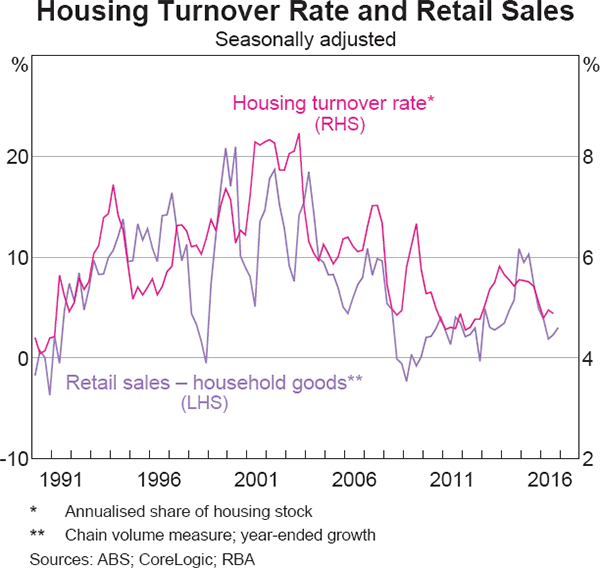
Another indirect channel through which housing market turnover can affect economic activity is housing prices. A common feature of housing markets in advanced economies is a positive correlation between housing price growth and turnover. One strand of literature posits that changes in housing turnover can lead changes in housing prices if buyers and sellers have incomplete information about market conditions (Wheaton 1990).[12] Changes in housing prices can subsequently affect household consumption via the household wealth channel (Muellbauer and Murphy 1990). Housing price growth can also affect dwelling investment by altering the expected return on investment, with flow-on effects for incomes and employment in related industries.
Changes in the composition of housing turnover, in particular the increase in the share of off-the-plan apartment sales, can affect the relationship between turnover, housing loan approvals and credit. For a typical sale of an existing property financed by a mortgage, the time between the contract date and settlement date is relatively short (around six to eight weeks). As a housing loan approval usually occurs about five to six weeks before settlement, this implies a short lag between housing turnover (recorded at the contract date) and loan approval. Credit is then drawn down at settlement of the transaction. As discussed above, off-the-plan apartments are commonly purchased before construction meaning that the lag between the contract date and settlement date can be around two or three years. As such, the loan approval and drawdown of credit does not occur until well after the initial contract is agreed (see ‘Box A: Housing Market Turnover and Housing Finance’ for more details).
Furthermore, housing turnover has a more general effect on household balance sheets.
Higher rates of housing turnover have been associated with periods of housing equity withdrawal, which indicates an excess of mortgage borrowing over new investment in housing, and was seen in Australia for much of the early to mid 2000s (Graph 9) (RBA 2003). This relationship occurs because a housing transaction typically involves the buyer taking on more debt to finance the purchase than the seller has outstanding against the property (Schwartz et al 2006; Greenspan and Kennedy 2008; Reinold 2011).[13] As a result, the current low level of the housing turnover rate might be expected to result in lower household leverage than otherwise.[14]
Relatedly, lower rates of housing turnover will tend to increase the average age of housing loans and the level of mortgage buffers. Households with newer or larger mortgages have had less time to build up buffers, consistent with data from the HILDA Survey which show that borrowers with small or no buffers tend to be younger or have more recently taken out their loan (RBA 2012). Those households with large mortgage buffers tend to be older, suggesting they have had time to accumulate these.
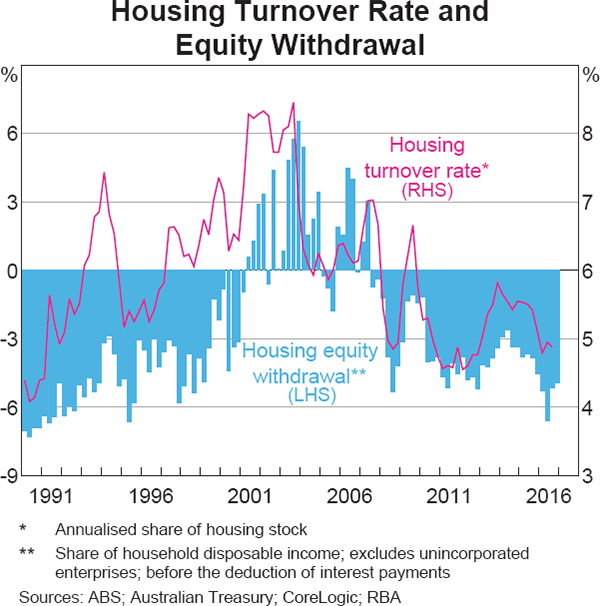
Conclusion
The housing turnover rate has trended lower since the early 2000s. One contributing factor we highlight in this article is a lower propensity for households to move home. Among the potential reasons for this could be lower rates of home ownership, particularly for younger households, and migration trends.
More recently, the sharp increase in off-the-plan sales of new apartments, which are difficult to measure in a timely manner, suggests that reported housing turnover is likely to be understated. Given the significant settlement lags associated with these sales, the relationship between housing turnover and credit growth also appears to have weakened. Nevertheless, the longer-run decline in the rate of housing turnover suggests that housing-related activity could make a smaller direct contribution to aggregate economic activity in the future, and may also lead to lower household leverage and higher mortgage buffers.
Box A
Housing Market Turnover and Housing Finance
There is a close relationship between housing market turnover and the total amount borrowed to purchase residential property. The amount borrowed as a proportion of the value of the property is known as the loan-to-valuation ratio (LVR). The total value of funds borrowed from financial intermediaries, or housing loan approvals, is equal to the amount borrowed on all housing transactions, including both existing housing and new housing completions. This differs from the measures of turnover described earlier, since the finance to purchase an off-the-plan property is only given final approval when construction nears completion, rather than when construction is approved. This means that the finance for off-the-plan housing occurs two or three years after the sale.
Housing loan approvals are related to changes in housing prices, the LVR, turnover of the existing housing stock and housing completions. For example, if housing prices rise, households have to borrow more to afford a given property, assuming an unchanged LVR. Higher LVRs increase total loan approvals because a greater proportion of each housing transaction is financed with debt. An increase in turnover of the existing housing stock or completions of new housing means that there is typically an increase in the number of households taking out new debt, since the majority of housing transactions require debt financing.
Decomposing the change in total housing loan approvals into contributions from these elements allows a more detailed analysis of the drivers of housing finance (although it should be noted that this analysis reflects co-movement, rather than a causality of the relationship in a specific direction).[1] This shows that, for Australia, turnover of existing housing has been an important driver of trends in loan approvals since 2009 (Graph A1). Over the past two years, its contribution to new housing finance has been declining. Over the same period, housing prices have been making a large contribution to growth in housing finance. The decline in turnover of existing housing goes some way to explaining why housing credit growth has been relatively muted, despite rapidly rising housing prices.
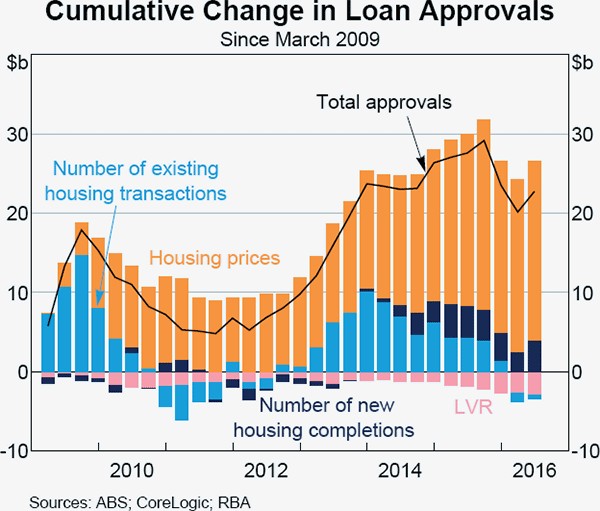
The contribution to loan approvals from the completion of new housing has been relatively small over the sample period, although it has been making a more noticeable contribution recently. The increase in off-the-plan apartment sales can be expected to contribute to more finance for new housing as these buildings are completed in coming years.
Lastly, it should be noted that the sale of new housing will generally contribute more to the outstanding stock of housing credit than the sale of existing housing. This is because the seller of an existing home will typically be another household rather than a property developer, which is likely to be the case when a new home is sold. As such, the funds raised from the sale of the existing home may be used to pay off existing housing debt.
Footnotes
Hannah Leal, Stephanie Parsons and Andrew Zurawski are from Economic Group. Graham White is from Domestic Markets Department. [*]
These data are matched with the state government data and are overridden when the official record of the transaction is available. [1]
This is consistent with ABS Census data which show a decline in the share of residents moving over the last two decades. [2]
The frequency with which renters move between dwellings has also declined, but these moves do not directly affect housing turnover as they do not involve the transfer of ownership. [3]
However, the Australian data have not shown strong evidence that transaction costs impede household mobility (Flatau et al 2002). [4]
This would not be the case if the frequency at which investors bought and sold housing was greater than owner-occupiers. Unfortunately, the available turnover data are not disaggregated by owner-occupier and investor purchases. Data from the ABS Census and National Regional Profiles (for 2011 and 2013, respectively) provide some evidence that local government areas with higher rates of home ownership tend to report higher rates of housing turnover. This relationship holds even when controlling for other variables which may affect home ownership rates, such as income and age. [5]
Additionally, older people are much less likely to finance a new housing purchase with a loan, and if they do, the loan size is typically much smaller. Such a compositional change implies a smaller level of credit per housing transaction than otherwise. [6]
However, liaison suggests that one recent motivation of foreign buyers of Australian property has been to provide housing for children while they study in Australia (Shoory 2016). [7]
Higher-density building approvals include apartments as well as semi-detached houses, but apartments have been the main driver of the increase in approvals in recent years (Shoory 2016). [8]
While the volume of turnover attributed to existing houses, new houses and new apartments does not change in this scenario, their share of total turnover is reduced proportionate to the increase in the share of existing apartments. [9]
We achieved comparable results using turnover data from CoreLogic. [10]
This excludes revenue from the transfer of goods and services tax to the states. [11]
The literature also puts forward explanations for reverse causality between housing prices and turnover, highlighting loss aversion of sellers and binding financing constraints (Stein 1995; Genesove and Mayer 2001). [12]
Examples where this is especially the case would be when the transaction involves last-time sellers such as retirees or people moving overseas. [13]
While lower housing equity withdrawal can reduce funds available for consumption, research suggests that this effect has been small in Australia (Schwartz et al 2006). [14]
Footnote Box A
Loans for refinancing and the construction of new housing with no transfer of ownership will not be associated with housing sales and are therefore excluded from this analysis. [1]
References
Bachmann R and D Cooper (2014), ‘The Ins and Arounds in the US Housing Market’, Federal Reserve Bank of Boston Research Department Working Papers No 14-3.
Flatau P, M Forbes, G Wood, P Hendershott and L O'Dwyer (2002), ‘Home Ownership and Unemployment: Does the Oswald Thesis Hold for Australian Regions?’, Murdoch University School of Management and Government Working Paper No 189.
Genesove D and C Mayer (2001), ‘Loss Aversion and Seller Behavior: Evidence from the Housing Market’, The Quarterly Journal of Economics, 116(4), pp 1233–1260.
Greenspan A and J Kennedy (2008), ‘Sources and Uses of Equity Extracted from Homes’, Oxford Review of Economic Policy, 24(1), pp 120–144.
Kaplan G and S Schulhofer-Wohl (2015), ‘Understanding the Long-run Decline in Interstate Migration’, Federal Reserve Bank of Minneapolis Working Paper Working Paper No 697.
Khoo S-E, P McDonald, J Temple and B Edgar (2012), ‘Scoping Study of Migration and Housing Needs’, Report for National Housing Supply Council Unit, Department of the Treasury, 31 May. Available at <http://apo.org.au/node/32970>.
Molloy R, C Smith and A Wozniak (2014), ‘Declining Migration within the US: The Role of the Labor Market’, NBER Working Paper No 20065.
Muellbauer J and A Murphy (1990), ‘Is the UK Balance of Payments Sustainable?’, Economic Policy, 5(11), pp 347–395.
Olsberg D and M Winters (2005), ‘Ageing in Place: Intergenerational and Intrafamilial Housing Transfers and Shifts in Later Life’, AHURI Final Report No 88, Australian Housing and Urban Research Institute Limited, 1 October. Available at <https://www.ahuri.edu.au/research/final-reports/88>.
RBA (Reserve Bank of Australia) (2003), ‘Housing Equity Withdrawal’, RBA Bulletin, February, pp 50–54.
RBA (2012), ‘Box B: Households' Mortgage Prepayment Buffers’, Financial Stability Review, September, pp 49–50.
RBA (2015), ‘Submission to the Inquiry into Home Ownership’, House of Representatives Standing Committee on Economics Inquiry into Home Ownership, June.
Reinold K (2011), ‘Housing Equity Withdrawal since the Financial Crisis’, Bank of England Quarterly Bulletin, 51(2), pp 127–133.
Schwartz C, T Hampton, C Lewis and D Norman (2006), ‘A Survey of Housing Equity Withdrawal and Injection in Australia’, RBA Research Discussion Paper No 2006-08.
Shoory M (2016), ‘The Growth in Apartment Construction in Australia’, RBA Bulletin, June, pp 19–26.
Stein JC (1995), ‘Prices and Trading Volume in the Housing Market: A Model with Down-Payment Effects’, The Quarterly Journal of Economics, 110(2), pp 379–406.
Wheaton W (1990), ‘Vacancy, Search, and Prices in a Housing Market Matching Model’, Journal of Political Economy, 98(6), pp 1270–1292.